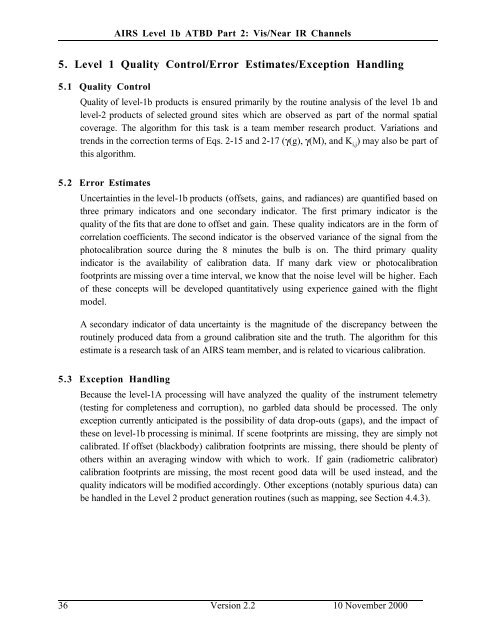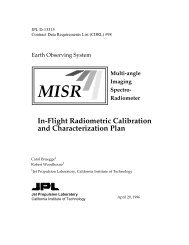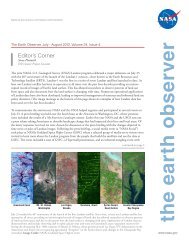AIRS Level 1B Visible/Near-Infrared Channels ATBD - NASA's Earth ...
AIRS Level 1B Visible/Near-Infrared Channels ATBD - NASA's Earth ...
AIRS Level 1B Visible/Near-Infrared Channels ATBD - NASA's Earth ...
You also want an ePaper? Increase the reach of your titles
YUMPU automatically turns print PDFs into web optimized ePapers that Google loves.
<strong>AIRS</strong> <strong>Level</strong> 1b <strong>ATBD</strong> Part 2: Vis/<strong>Near</strong> IR <strong>Channels</strong><br />
5. <strong>Level</strong> 1 Quality Control/Error Estimates/Exception Handling<br />
5.1 Quality Control<br />
Quality of level-1b products is ensured primarily by the routine analysis of the level 1b and<br />
level-2 products of selected ground sites which are observed as part of the normal spatial<br />
coverage. The algorithm for this task is a team member research product. Variations and<br />
trends in the correction terms of Eqs. 2-15 and 2-17 (γ(g), γ(M), and K i,j<br />
) may also be part of<br />
this algorithm.<br />
5.2 Error Estimates<br />
Uncertainties in the level-1b products (offsets, gains, and radiances) are quantified based on<br />
three primary indicators and one secondary indicator. The first primary indicator is the<br />
quality of the fits that are done to offset and gain. These quality indicators are in the form of<br />
correlation coefficients. The second indicator is the observed variance of the signal from the<br />
photocalibration source during the 8 minutes the bulb is on. The third primary quality<br />
indicator is the availability of calibration data. If many dark view or photocalibration<br />
footprints are missing over a time interval, we know that the noise level will be higher. Each<br />
of these concepts will be developed quantitatively using experience gained with the flight<br />
model.<br />
A secondary indicator of data uncertainty is the magnitude of the discrepancy between the<br />
routinely produced data from a ground calibration site and the truth. The algorithm for this<br />
estimate is a research task of an <strong>AIRS</strong> team member, and is related to vicarious calibration.<br />
5.3 Exception Handling<br />
Because the level-1A processing will have analyzed the quality of the instrument telemetry<br />
(testing for completeness and corruption), no garbled data should be processed. The only<br />
exception currently anticipated is the possibility of data drop-outs (gaps), and the impact of<br />
these on level-1b processing is minimal. If scene footprints are missing, they are simply not<br />
calibrated. If offset (blackbody) calibration footprints are missing, there should be plenty of<br />
others within an averaging window with which to work. If gain (radiometric calibrator)<br />
calibration footprints are missing, the most recent good data will be used instead, and the<br />
quality indicators will be modified accordingly. Other exceptions (notably spurious data) can<br />
be handled in the <strong>Level</strong> 2 product generation routines (such as mapping, see Section 4.4.3).<br />
36 Version 2.2 10 November 2000







